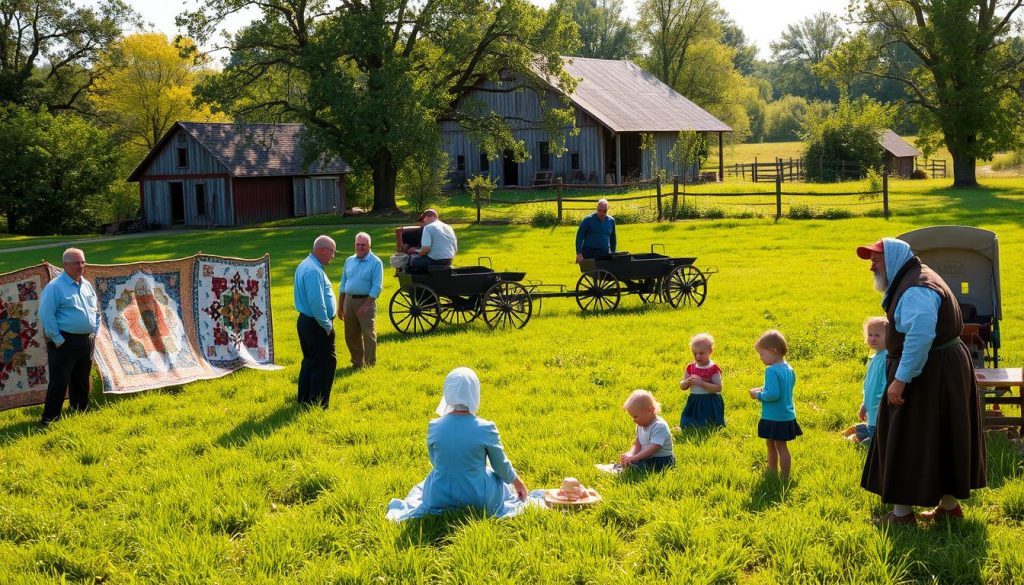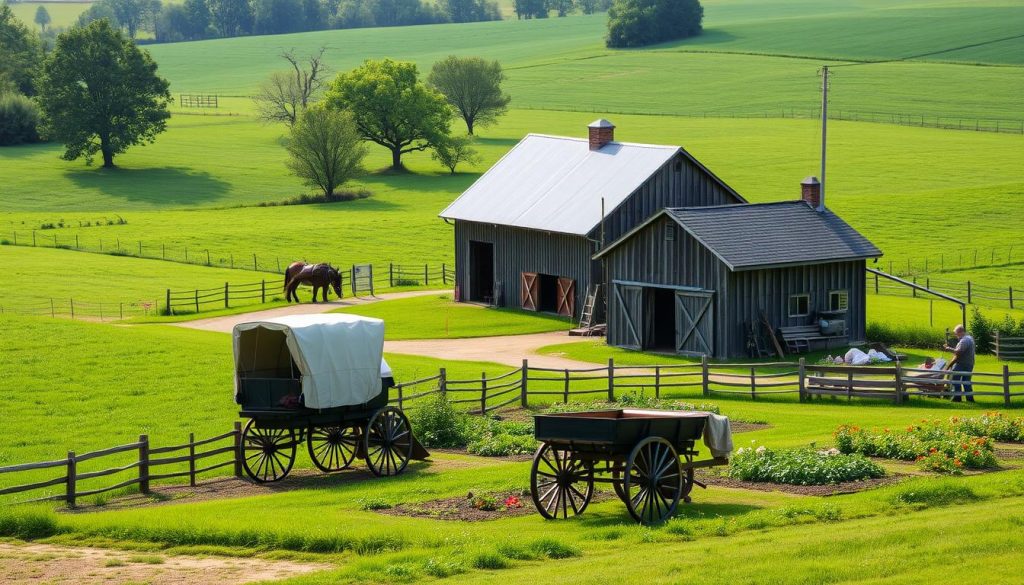The Amish: Preserving Simplicity in a Modern World.
The Amish community is a shining example of simplicity in a changing world. With over 318,000 members, they live a life filled with tradition and community.
Anúncios
Places like Lancaster County attract millions, eager to see their unique way of life.
Since 1737, the Amish have found a way to live in today’s world while staying true to their beliefs. They focus on family and faith, not just material things.
Their way of life makes us think about what truly brings happiness in a world full of consumerism.
Introduction to the Amish Community
The Amish community is known for its simple and humble way of life. They focus on strong family bonds and mutual support. With about 1,925 congregations in North America, they showcase a rich culture and identity.
Anúncios
They live mainly in rural areas like Lancaster County, Pennsylvania. The Amish avoid modern technology to focus on their spiritual beliefs and social connections.
Their traditional dress shows their values and sets them apart from others. They use horse-and-buggies for transport, showing their rejection of modern conveniences. The Amish mainly farm, connecting them to the land and upholding their identity.
Despite myths about their isolation, the Amish are open to sharing their traditions. Events like barn-raising and communal meals highlight their importance of collective support. These practices contrast with mainstream American culture, which values technology and individualism. For more on their traditions and beliefs, check out this link.

The Historical Roots of the Amish
The Amish community has a rich and complex history. It started with the Anabaptist movement in Europe in the 16th century. This group wanted to follow their faith without persecution.
In 1737, the first Amish immigrants came to North America on the Charming Nancy. They settled in Pennsylvania, focusing on community and faith. They didn’t want to mix with the outside world.
The Amish faced many challenges, especially about education. They opposed Pennsylvania’s school laws to keep their traditions. Today, the Lancaster County Amish have grown to about 43,500, showing their strong commitment.
The Amish origins come from Anabaptist beliefs in adult baptism and community living. They are part of the Anabaptist family, including Mennonites and Brethren. The Old Order Amish, the most traditional, reject modern technology.
Amish history is shaped by their move to North America and sticking to their values. These values are key to their identity. They live in humility, family, and community, without a central leader.
| Year | Event | Significance |
|---|---|---|
| 1525 | Anabaptist Movement Founded | Emphasized adult baptism |
| 1737 | First Amish Migration to North America | Initiated Amish presence in the U.S. |
| 1862 | First All-Church Ministers’ Conference | Addressed issues of community |
| 1972 | Wisconsin v. Yoder Ruling | Acknowledged religious freedoms of the Amish |
Core Values of the Amish Lifestyle
The Amish community is deeply rooted in core values. These values include faith, family, community, and simplicity. These principles guide their personal behaviors and communal interactions. They foster an environment where relationships flourish.
Faith is the bedrock of Amish life. They have regular church services in members’ homes, with almost 100% attendance. This collective worship emphasizes humility and discipline. It aligns members with a higher moral authority.
Adult baptism is significant, with over 95% of individuals baptized by age 21. This reaffirms their commitment to communal beliefs.
Family is vital in the Amish culture. About 80% of families have six or more children, seeing each child as a blessing. This focus on family strengthens bonds and creates multigenerational living arrangements.
Early marriage, typically between ages 20 and 22, further establishes strong family networks. These networks contribute to the community’s stability.
Community life thrives on cooperation and mutual support. Events like barn-raisings show the value of coming together. With around 2,000 congregations nationwide, the community’s structure enhances the sense of belonging.
Reports show that 90% of children remain within the community after their rumspringa. They choose the lifestyle their parents uphold.
Simplicity is a fundamental Amish value. It manifests in daily practices. Many communities avoid electrical appliances, opting for traditional farming methods.
About 50% of community members engage in farming. This emphasizes hard work and personal accomplishment over material gain. Handcrafted goods like woodworking and basket weaving are their primary income sources. They reinforce simplicity and sustainability.
| Core Values | Examples | Impact on Community |
|---|---|---|
| Faith | Regular church gatherings, adult baptism | Creates a moral framework and sense of unity |
| Family | Large family sizes, early marriage | Strengthens bonds and fosters multigenerational living |
| Community | Barn-raisings, strong congregational ties | Encourages cooperation and long-lasting relationships |
| Simplicity | Avoidance of technology, handcrafted goods | Promotes self-sufficiency and a focus on essential needs |

Modern vs. Traditional Living: The Amish Perspective
The Amish community shows a clear view on traditional living in a world full of modern technology. They stick to their cultural ways but also deal with today’s world. This shows the complexity of their life in today’s fast-paced world.
The Amish make smart choices about technology. They don’t reject all modern things. Instead, they use tools that help them work better, especially in business. This way, they keep their traditional way of life while using some modern tools.
The Amish really value keeping their culture alive. They face changes but focus on their community and faith. For example, they still do communal work and family gatherings. These activities keep their community strong and their culture alive.
The Amish population has grown a lot over the years. From 6,000 in 1900 to 318,500 in 2017, they are growing fast. This shows their strong culture can grow even with the challenges of modern life.
In short, the Amish mix traditional living with smart use of modern technology. They aim to keep their culture alive while living in today’s world. Their story teaches us about keeping our identity strong, even with big changes.
How the Amish Adapt to Technology
The Amish community carefully chooses how to use technology. They reject TVs and personal computers but use battery-operated devices. They also adopt solar power for energy. This way, they keep their traditions and community strong.
They value practical skills over formal education. Most Amish communities don’t use public electricity. Instead, they use 12-volt batteries for their needs. This shows their self-sufficiency and resistance to fast social changes.
About 10-15% of Old Order Amish use phones. But many rely on battery-operated systems for everyday tasks. This balance helps them stay connected yet true to their values.
Tourism brings both benefits and challenges to the Amish. More visitors can boost their economy but also lead to misunderstandings. Legal fights over education show their ongoing struggle for religious freedom. Yet, the Amish adapt their economy, based on farming and crafts, while dealing with technology.
